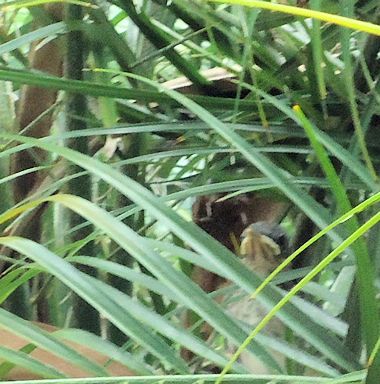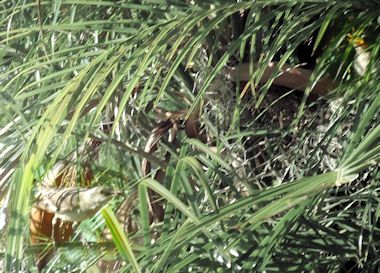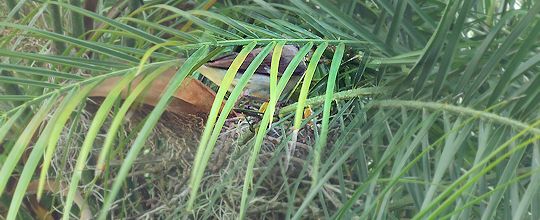If you follow this blog, you know my husband and I have moved to Florida. It’s been a long two weeks, but we are now settled in our temporary housing, a nice home in the same community where we will be building a new home. (Yes, another move!)
Here in my new space, my desk sets right next to a window, looking out over some garden palms. Pretty, and I thought maybe peaceful, too. I’d be able to get some work done – a quiet place to work on APHA business and book writing…
Until early last week when I began to hear chirping noises out the window, only to discover that interwoven in the base of the palm fronds, among a tangle of Spanish moss, there sat a bird nest – with babies in it! Since then I have been fascinated (my husband would call it “obsessed”) with all the activity, watching two adult birds leave then return then leave again from no more than 8 feet away. And then, two days ago, I could see the babies for the first time. Two of them, their little yellow beaks wide open, popping up and down inside the nest, chirping loudly and continuously. “We’re hungry! Bring us more food!”
I’ve never been more than casually interested in birds, but of course, this experience has piqued my interest, and I’ve now spent some time studying these birds and their habits. It took me a while to figure out what kind of bird they are. Gray, adults with white underbellies, a white “stripe” through their wings, babies with streaked underbellies. I finally settled on the Northern Mockingbird, which would explain why it was difficult to hear a consistent song. All this observation and study has done some serious damage to all that time I thought I’d be able to devote to catching up on my work!
 The babies seem to have two distinct personalities. One seems quite bold, and while waiting for Mom or Dad to bring food (because both Mockingbird parents feed their young) she stands on the rim of the nest waiting, preening her feathers, curious about her world, and looking as if she’s ready to do whatever is next – like fly. Her sibling rarely pops her head up and out of the nest, preferring, it seems, to wait patiently for her next meal.
The babies seem to have two distinct personalities. One seems quite bold, and while waiting for Mom or Dad to bring food (because both Mockingbird parents feed their young) she stands on the rim of the nest waiting, preening her feathers, curious about her world, and looking as if she’s ready to do whatever is next – like fly. Her sibling rarely pops her head up and out of the nest, preferring, it seems, to wait patiently for her next meal.
That observation is what prompted today’s post – the parallels between the baby birds getting ready to fly, and new advocates who prepare to launch their new practices. Some are bold, willing and eager to take flight. Others are more reticent, just hanging on to what they perceive as the security of not-quite-ready-wish-I-could-but-I-just-can’t.
Which bird are you?
I’ve written before on the Paralysis of Analysis. It’s the concept that explains why, when you spend too much time thinking about the potential risk, you lose confidence, and that gets in the way of your launch and success. As a soon-to-be-business-owner, you’ll need to overcome that if you want to be successful.
One big difference, of course, is that no bird ever just gives up, backs away, and continues to do what he or she has always done expecting different results (the definition of insanity, by the way.) Mother Nature will force these birds from their nests, and unless something else gets in their way, they will successfully launch, and will fly and thrive for the rest of their bird lives.
 Another big difference is that when these baby birds fly, they won’t do so to benefit anyone else. No other creature needs them (until they have babies, of course.) Advocates are in a very different position. When an advocate doesn’t take flight, then potentially thousands of patients and caregivers won’t get what they need. So postponing one’s practice launch (or giving up on it all together) means other people will suffer.
Another big difference is that when these baby birds fly, they won’t do so to benefit anyone else. No other creature needs them (until they have babies, of course.) Advocates are in a very different position. When an advocate doesn’t take flight, then potentially thousands of patients and caregivers won’t get what they need. So postponing one’s practice launch (or giving up on it all together) means other people will suffer.
That’s quite a burden.
If you have launched your practice, then kudos to you for jumping out of the nest and getting on with the business of helping others.
And if you haven’t? Well? What are you waiting for? Neither of these baby birds will analyze their ability to take flight. They will just do it.
If these baby birds can do it, you can too!
Update! Within 3 hours of publishing this post, both baby birds had made their first attempt at flight. Neither one did well at first, but 24 hours later they had both improved. Two days later – no more activity in or near the nest at all. Success! (Oh, but I miss watching them!)
LEARN ABOUT APHA MEMBERSHIP | FIND MORE REASONS PATIENTS NEED ADVOCATES
Photos: Taken through the window. Top photo is Mom or Dad feeding both babies (two yellow beaks). Middle photo is the bold baby. Bottom photo – see parent in lower left and baby in upper right.






Great analogy Trisha. I did spend quite a it bit of time researching and preparing. I did tell myself and it others, “I want to get it right, there is a lot at stake.” Surely there was. Then, a call from my first client. There is nothing like a call to action and the excitement of your first client to launch you! Did I know everything? Certainly not. I had prepared enough to have know I knew what I needed to do and do a good job for my client. That client left me hungry for the next. I learn something knew with every client. Its always is something that surprises me. It’s a great feeling to launch. Nothing quite like it. It was nerve wracking and a bit scary. The unknown is always scary. I’ve been in healthcare for 25+ years and I’ve started a business. This was different. This was being the point person that the family chose, to make sure their family member was well cared for and safe. I chose my type of practice because I knew I could do it well. The pay off is worth the risk!! To all of the advocates stuck, waiting, even questioning, there are many people, right now, that desperately need you and your expertise. Show up for them. Fly!